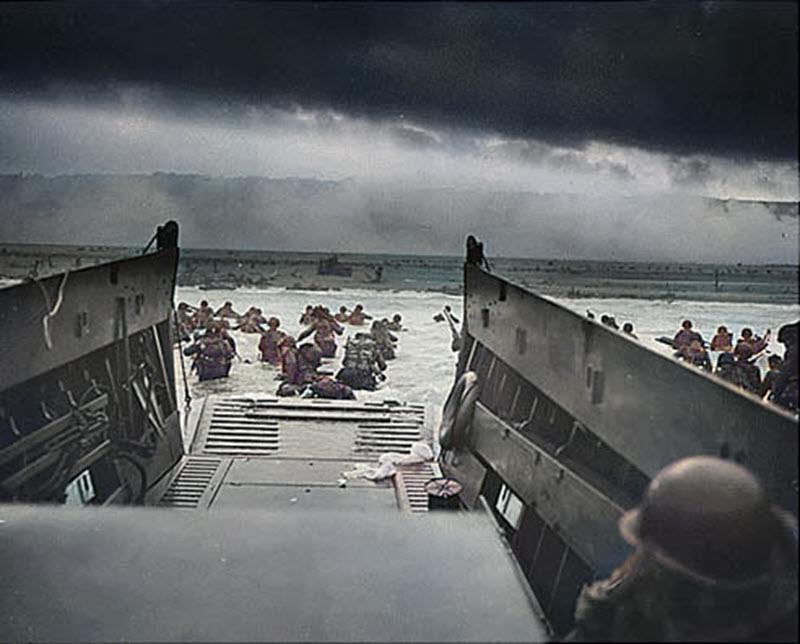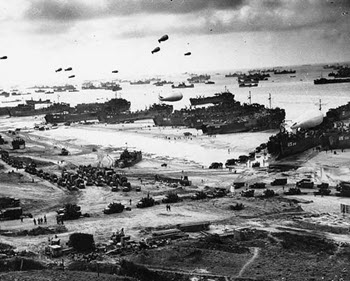
Iconic Photograph of an American landing Craft on the Normandy Beaches. Allied soldiers disembark from a landing craft on the Normandy landing beaches. (Colorized photo)
D-Day Landings
The D-Day Landings constituted the allied invasion of Nazi occupied France as part of the overall plan to liberate Europe. The code name for the Normandy Invasion, which involved the most massive amphibious and airborne landings in the history of the world, was code named Overlord. Altogether 3 million allied military personnel were involved.
As part of the D-Day landings the allies launched coordinated sea borne and airborne assaults against Normandy France. The bulk of the allied armies landed by sea in small amphibious crafts that took them from waiting troop ships to the beaches of Normandy France. The allies landed on six beaches, code named Utah, Omaha, Gold, Juno, and Sword.
The allied code names of the beach landings had originally been given less impressive names such as "Jellyfish" but Prime Minister Winston Churchill of Britain insisted that they be renamed arguing that men were being asked to die for these beaches, and therefore the names should be more dignified. A few days before the allied D-Day landings, a British newspaper published a crossword puzzle which had as its answer the same names as the D-Day landings, namely Utah, Omaha, Gold, Juno, and Sword. Allied intelligence feared that its security had been breached and that this was an attempt to communicate the plans to secret German agents.
However an investigation revealed that this was simply an amazing coincidence. At least that is the official story. However, in my view the chances of a crossword puzzle writer independently coming up with all six of the code names for the D-Day landings, just days before the actual Normandy invasion seems too statistically improbable. Perhaps the puzzle was a coded message after all, and allied intelligence simply did not want to admit the possibility.
Normandy Invasion
The allied landings on D-Day were made under very impressive secrecy and achieved the element of surprise. Although the Germans had known for quite some time that the Allies would attempt to land in France, they did not know when or where and as a result they were forced to defend large sections of the Normandy coast as well as areas farther north including Belgium. Hitler, in typical fashion, stripped his commanders of authority and took command of the defences, which made German opposition to the allied landings less effective. Hitler believed that the allies would land at Pas de Calais, the closest point to England and he concentrated many of his best panzer divisions there. Even after the landings actually began, the German high command was not sure if the D-Day landings were simply a diversion for a larger landing elsewhere. As a result, many German units did not immediately move to counterattack and remained in defensive positions elsewhere along the coast.
When German units did move against the allied D Day beaches their movements were hampered by intensive allied air bombardment which destroyed bridges and paratroopers and French resistance fighters. Many German divisions were under strength and had been transferred to France to recuperate after suffering severe losses on the Russian front. Nevertheless, the Germans did manage to put up effective initial resistance against the allied D Day landings and for a time the outcome was in doubt. If the allied landings had failed, it would have meant monumental losses for the allies as well as a severe loss of prestige and morale. General Eisenhower, in overall command of the allied forces, was not certain of victory and had already penned a communique that he would release in the event that the invasion failed.
German propaganda newsreels from the first days of the fighting portrayed the D-Day landings as a failure and claimed that the Allies had been repulsed. These were not just lies put out by the German propaganda ministry. In many places, the outcome of the landings was seriously in doubt, and even after the British, Americans and Canadians were able to move inland, they continued to meet stiff German resistance.
The allied D Day beaches were chosen because of their terrain and proximity to England which allowed fighter planes based in Britain to fly air support over the beaches. The day of the landings. June 6, 1944, was chosen because the tide conditions made a landing easier. However the landings were almost canceled due to extremely bad weather. It was only after allied weathermen were able to predict a period of calm weather over the beaches on June 6, that the order to go ahead was given. It is amazing that the allied weather predictors got it right in 1944 without the aid of satellites or doppler radar, yet today most weather channels cannot accurately predict if it will rain this weekend.
Once the allied beach heads were established the allies were able to break out of the initial D Day beaches and push inland through Normandy on the way to Paris. Today, the site of the D-Day landings are tourist destinations. Men and women who fought in the war, as well as their children and grandchildren often return to view the site of the fighting. There are many companies that offer D-Day Battlefield Tours.

Tankers of the 761st Medium Tank Battalion, 1944
| Home | | Normandy Invasion | | Normandy Fighting | | German Counter Attacks |
This site is dedicated to the History and Culture of Beautiful Normandy France.



